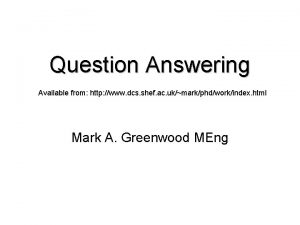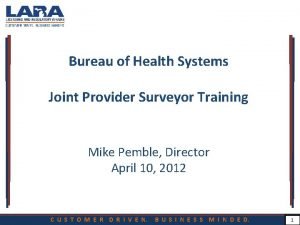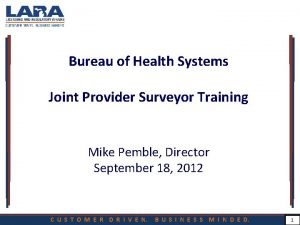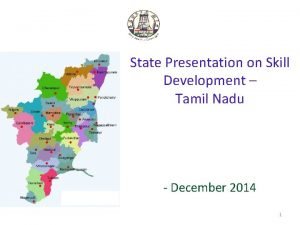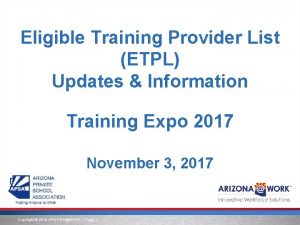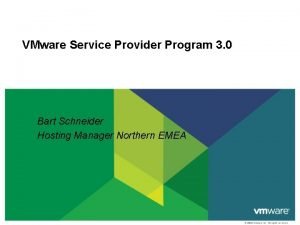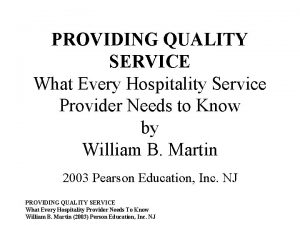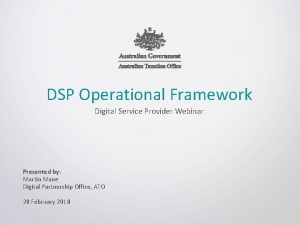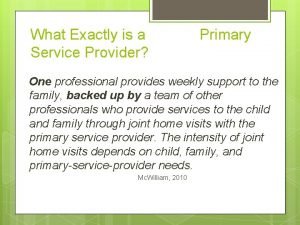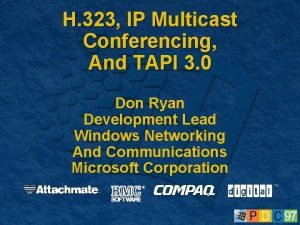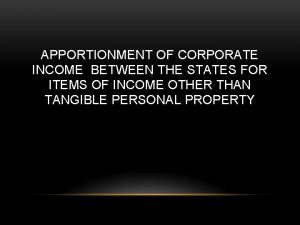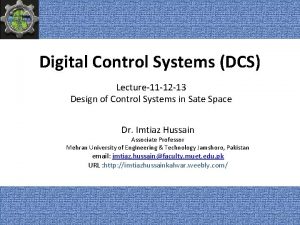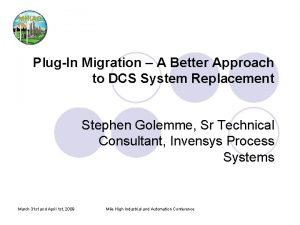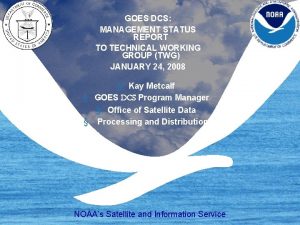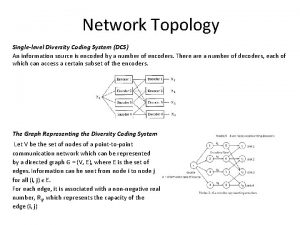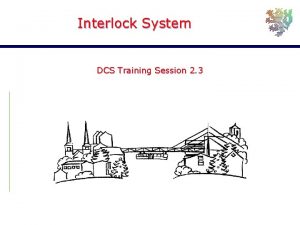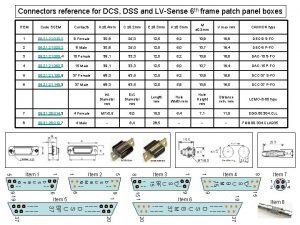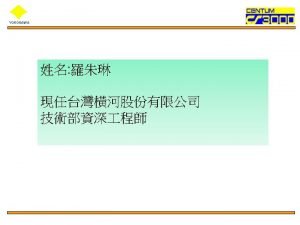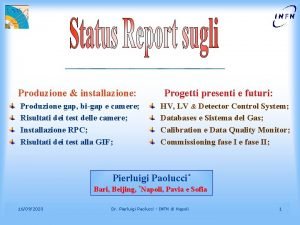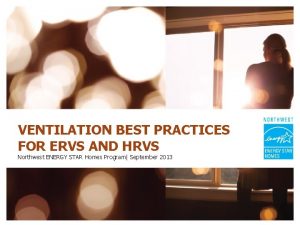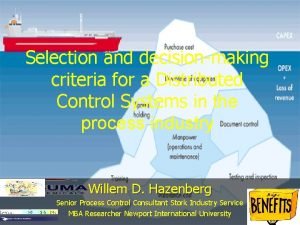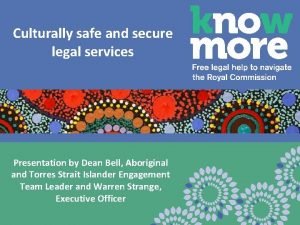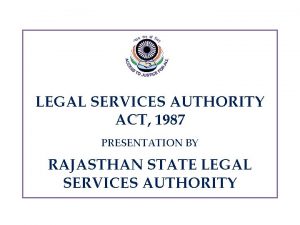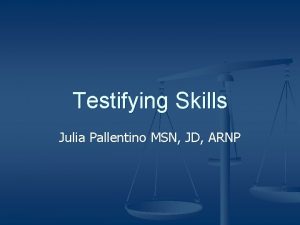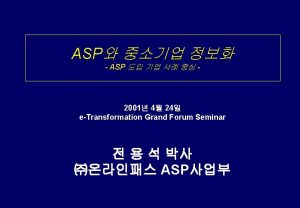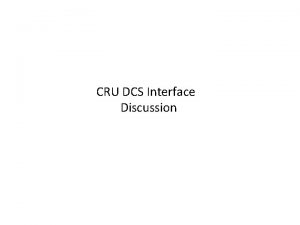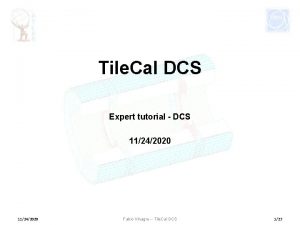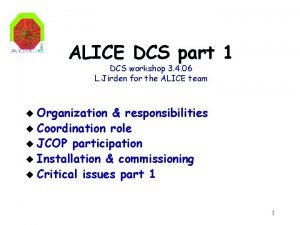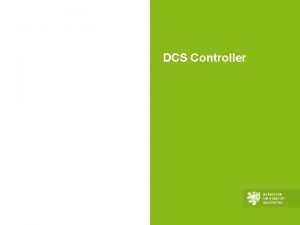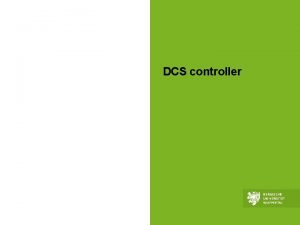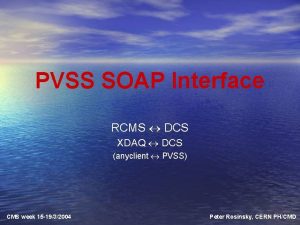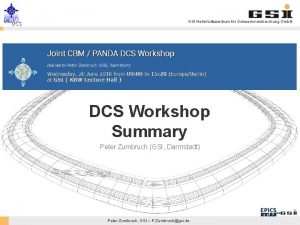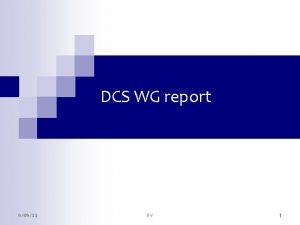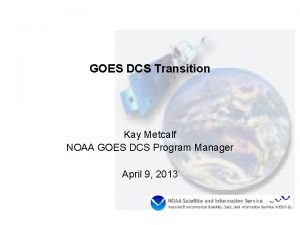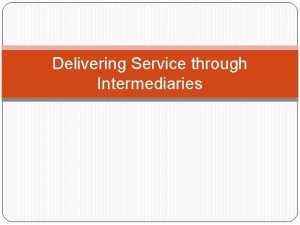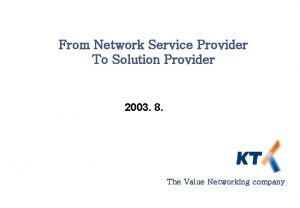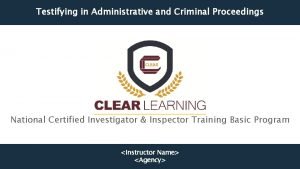DCS Service Provider Training Legal and Testifying For
















































































- Slides: 80

DCS Service Provider Training: Legal and Testifying For use by DCS Contracted Service Providers

Course Competencies Upon completion of this course, participants will be able to: • Recognize different types of law • Describe each of the CHINS statutes • Differentiate between Standards of Proof • Identify Types of Evidence • Understand Rights and Due Process Children thrive in safe, caring, supportive families and communities 2

Before We Begin What you need: Paper and writing utensil – you may want to take some notes Quiet Space – you’ll need to focus your attention on the information presented 30 -45 Minutes – set aside plenty of time to review this training in one setting if possible Children thrive in safe, caring, supportive families and communities 3

DCS Service Provider Training: Legal and Testifying TYPES OF LAW

State Statutory Laws are passed by a legislature at the state level. Statutes set forth general propositions of law that courts apply to specific situations. Children thrive in safe, caring, supportive families and communities 5

State Statutory Law (continued) CHINS statutes are one form of statutory law. In Indiana, our state law is written into statutes, known as the Indiana Code. In terms of child welfare work, we deal primarily with the Indiana Code Title 31, found here: https: //iga. in. gov/legislative/laws/2017/ic/ *You may need to update the year (2017) to the current year in the URL box Children thrive in safe, caring, supportive families and communities 6

Case Law defines statutory law in specific situations. Case law is created by decisions of appeals courts which make new interpretations of the law and, therefore, can be cited as precedents. Children thrive in safe, caring, supportive families and communities 7

Case Law (continued) For example, CHINS statute does not specifically define the standards of physical abuse. The appeals courts consider a specific case and make a decision on whether or not a case involves physical abuse based on evidence. This decision becomes precedent. Now other courts can look at that precedent for guidance. Children thrive in safe, caring, supportive families and communities 8

Making Connections Case law is created in the appeals courts. Statutory law is written by legislative bodies. Case law is a dynamic and constantly developing body of law. Children thrive in safe, caring, supportive families and communities 9

Administrative Law is the kind of law that governs the administrative agencies of the state. Those laws are known as the administrative code. Children thrive in safe, caring, supportive families and communities 10

Administrative Law (continued) Foster care licensing and daycare licensing laws are examples of Administrative law. Substantiations are appealed via administrative law. Children thrive in safe, caring, supportive families and communities 11

Administrative Law (continued) Administrative Laws that govern Child Welfare work: • Indiana Administrative Code – found at http: //www. in. gov/legislative/iac_title • Title 465 Article 2 – Child Welfare Services – outlines requirements for foster care homes, group homes, licensing related to taking care of children placed in care, CAPTA, adoption subsidies. Children thrive in safe, caring, supportive families and communities 12

Policy and Local Practice Policy is an agency’s interpretation of the law. It is how the agency comes into compliance; but policy is not law. Policy is supported by the law. DCS policy can be found on the DCS website: http: //www. in. gov/dcs/ Children thrive in safe, caring, supportive families and communities 13

Policy and Local Practice (continued) Laws are developed to provide regulation to state agencies DCS develops policy based on law Your agency develops its own policy/procedure based on law and DCS policy Children thrive in safe, caring, supportive families and communities 14

Policy and Local Practice (continued) Local Practice refers to how policy is handled in a particular county. Example: The law states that a child can be removed without a court order in certain circumstances. However, in some counties judges have determined that children in their counties cannot be removed without their approval. In some cases, the judge expects to be called in the middle of the night. Children thrive in safe, caring, supportive families and communities 15

Activity: Which is it? On the following slides, you will see the law, code, or policy at the top of the slide. You then click on the category you think is correct to find more information. Children thrive in safe, caring, supportive families and communities 16

Indiana Administrative Code, Title 465, Article 2 State Statute Case Law Administrative Law Policy Children thrive in safe, caring, supportive families and communities 17

Indiana Administrative Code, Title 465, Article 2 That is not correct. The clue in the title is ‘Administrative Code’ BACK Children thrive in safe, caring, supportive families and communities 18

Indiana Administrative Code, Title 465, Article 2 That is correct! This Administrative Law pertains to Foster Care Licensing. The name indicates this is an administrative code, which is the type of law that governs administrative agencies. NEXT Children thrive in safe, caring, supportive families and communities 19

Indiana Code (IC) 31 -34 -1 -8 Missing Child State Statute Case Law Administrative Law Policy Children thrive in safe, caring, supportive families and communities 20

Indiana Code (IC) 31 -34 -1 -8 Missing Child That is not correct. The clue in the title is ‘Indiana Code’ BACK Children thrive in safe, caring, supportive families and communities 21

Indiana Code (IC) 31 -34 -1 -8 Missing Child That is correct! This is a State Statute pertaining to CHINS (Child in Need of Services) which will be covered later in this training. NEXT Children thrive in safe, caring, supportive families and communities 22

B. H. & B. H. (Minor Children), and T. H. (Mother), Appellant–Respondent, v. The INDIANA DEPARTMENT OF CHILD SERVICES, Appellee–Petitioner. No. 52 A 02– 1210–JT– 849. |May 30, 2013. State Statute Case Law Administrative Law Policy Children thrive in safe, caring, supportive families and communities 23

B. H. & B. H. (Minor Children), and T. H. (Mother), Appellant–Respondent, v. The INDIANA DEPARTMENT OF CHILD SERVICES, Appellee–Petitioner. No. 52 A 02– 1210–JT– 849. |May 30, 2013. That is not correct. The clue in the title is in the ‘v. ’, as that indicates a court case. BACK Children thrive in safe, caring, supportive families and communities 24

B. H. & B. H. (Minor Children), and T. H. (Mother), Appellant–Respondent, v. The INDIANA DEPARTMENT OF CHILD SERVICES, Appellee–Petitioner. No. 52 A 02– 1210–JT– 849. |May 30, 2013. That is correct! This was an Indiana Supreme Court decision that declared a family may sue the state’s child protection agency for negligence. For more information about this case see the following link: https: //www. in. gov/judiciary/opinions /pdf/05301302 nhv. pdf NEXT Children thrive in safe, caring, supportive families and communities 25

DCS Service Provider Training: Legal and Testifying CHINS Child in Need of Services

CHINS Statutes CHINS stands for Child in Need of Service. CHINS statutes are State Law. It is not necessary for service providers to memorize the CHINS specific incidents, however, it may be helpful to be familiar with them as you work with families and hear/discuss CHINS references in court. This section will serve as an overview of CHINS. For more information, refer to Indiana Code title 31 (link on Slide 6). Children thrive in safe, caring, supportive families and communities 27

Statute Specific Incidents CHINS 1: Neglect CHINS 2: Physical/Mental Abuse CHINS 3: Sexual Abuse CHINS 3. 5: Human or Sexual Trafficking Victim CHINS 1 -3 are the most commonly used CHINS Children thrive in safe, caring, supportive families and communities 28

Statute Specific Incidents (continued) CHINS 4: Obscene Performance CHINS 5: Parent Allows Child to Commit Sex Offense CHINS 6: Child Endangers Self or Other Child CHINS 7: School Disciplinary Proceeding CHINS 8: Missing Children thrive in safe, caring, supportive families and communities 29

Statute Specific Incidents (continued) CHINS 9: Disabled Child Denied Medical Care CHINS 10: Child born with fetal alcohol syndrome, neonatal abstinence syndrome, controlled substance, legend drug* CHINS 11: Injury, abnormal physical or psychological development, symptoms of neonatal intoxication or withdrawal due to drug use during pregnancy *Legend drug refers to drugs that are approved by the U. S. Food and Drug Administration (FDA) and that are required by federal or state law to be dispensed to the public only on prescription of a licensed physician or other licensed provider. Children thrive in safe, caring, supportive families and communities 30

A Child is Considered CHINS if: 1. 2. 3. 4. 5. The Child is under age 18 A statute specific incident occurs (CHINS 1 -11) The child needs care, treatment, or rehabilitation The child is not receiving care, treatment, or rehabilitation Care, treatment, or rehabilitation is unlikely to be provided or accepted without the coercive intervention of the court Children thrive in safe, caring, supportive families and communities 31

Court Appearance • Service Providers may be requested to testify in court – Requests my come via subpoena or written request form the DCS office (email or letter) • A Court Appearance is defined as appearing for a court hearing after receiving a written request or subpoena from DCS to appear in court, and can be billed per appearance – Therefore, if the provider appeared in court two different days, they could bill for 2 court appearances – Maximum of 1 court appearance per day • The Rate of the Court Appearance includes all costs associated with the court appearance – Additional costs associated with the appearance cannot be billed separately Children thrive in safe, caring, supportive families and communities 32

Types of Hearings Detention Initial Fact Finding Disposition Periodic Review Permanency • First Appearance • Service Provider unlikely to attend; unless services were previously offered • Initiate CHINS • Service Provider unlikely to attend; unless services were previously offered • Court rules on CHINS • SOME Service Providers may appear if services are provided during assessment • Hearing in which services are ordered • Service Providers are unlikely to appear, unless they have been providing other services • Update to the court regarding case progress • Service Providers may appear as needed • Update to the court regarding permanency • DCS can request change in permanency plan • Service Providers often appear Termination of Parental Rights • DCS argues in favor of terminating parental rights • Service Providers almost always appear Service Providers will receive a request to appear if and when their presence is required for any of the identified hearings. Requests provided via subpoena or email/letter from the local DCS office. Children thrive in safe, caring, supportive families and communities 33

DCS Service Provider Training: Legal and Testifying Standards of Proof

Standards of Proof A standard of proof is the level of proof demanded or required in a specific case. Different circumstances and courts require different standards of proof. We will address the different standards of proof, what they mean, and when and where you will apply them. Children thrive in safe, caring, supportive families and communities 35

Reasonable Suspicion (Low Standard of Proof) A quantum of proof less demanding than probable cause, but more than a hunch. There must be some minimal level of objective justification for the suspicion and there must be specific and articulable facts which, based on the totality of the circumstances, are sufficient to warrant reasonable suspicion. • • • Standard for making a report to the Child Abuse Hotline A service provider may use this standard if you observe a concerning incident or if a client you are already working with tells you something not related to the current DCS involvement For example, if you are completing Home Based Services with a family and arrive at the home to find a preschool age child home alone – this would be reasonable suspicion and prompt a call to the Hotline Children thrive in safe, caring, supportive families and communities 36

Probable Cause (25% Standard of Proof) A person has knowledge of facts and circumstances which warrant a person of reasonable caution to believe that the facts are correct. Involves reasonably trustworthy information. • Standard for taking a child into DCS custody • Visible evidence and fact based information is expected; hearsay is allowed • This standard is used at a Detention Hearing or filing CHINS – service providers are often not involved with families at this point Children thrive in safe, caring, supportive families and communities 37

Preponderance of the Evidence (51% Standard of Proof) Means the greater weight of the evidence. It is sometimes called ‘more likely than not’. The evidence given upon any fact that convinces you most strongly of its truthfulness is of the greater weight. • Standard required to determine CHINS • Enough evidence to lead a reasonable person to believe abuse/neglect has occurred • This standard is used at a Fact Finding Hearing – in some areas, services are in place at this point and service providers MIGHT be asked to testify Children thrive in safe, caring, supportive families and communities 38

Clear and Convincing Evidence (75% Standard of Proof) Requires the existence of a fact to be highly probable. • Standard required for Termination of Parental Rights • Increased formality in the courtroom due to the higher burden of proof • Service providers are often asked to testify in these hearings, as they will have valuable information regarding the people/families they have been working with Children thrive in safe, caring, supportive families and communities 39

Activity: How Much Proof is Necessary? On the following slides, read the scenario then select the correct Standard of Proof. Once you complete the activity, you can choose to try again if you did not answer each one correctly, or proceed to the next section. Children thrive in safe, caring, supportive families and communities 40

Scenario One You are a Forensic Interviewer for a child advocacy center. You have been asked to testify at a Fact-Finding Hearing regarding an interview you facilitated with a DCS client. Click on the correct Standard of Proof. Probable Cause Preponderance of the Evidence Children thrive in safe, caring, supportive families and communities 41

Scenario One That is incorrect. Fact Finding Hearings require a PROPONDERANCE OF THE EVIDENCE. This shows that Child Abuse or Neglect is or was more likely to occur than not. It is the responsibility of DCS to prove to the court that abuse or neglect occurred, and may use service provider testimony. Next Children thrive in safe, caring, supportive families and communities 42

Scenario One Fact Finding Hearings require a PROPONDERANCE OF THE EVIDENCE. This shows that Child Abuse or Neglect is or was more likely to occur than not. It is the responsibility of DCS to prove to the court that a child is in need of services due to the act or omission of a parent, caregiver, or guardian, and may use service provider testimony. Next Children thrive in safe, caring, supportive families and communities 43

Scenario Two You are a Counselor, providing individual counseling to a six year old child in foster care. During a counseling session, the child indicates that he doesn’t like the foster home because he has to babysit his 3 year old sister and another child in the home while his foster parents are at work on Saturday mornings. The child provides a detailed description of what he has to do with the younger sibling while babysitting (get breakfast, provide medicine, watch TV). You are confident this child is being truthful with you. Reasonable Suspicion Clear and Convincing Evidence Children thrive in safe, caring, supportive families and communities 44

Scenario Two That is incorrect. You have Reasonable Suspicion to contact the Child Abuse and Neglect Hotline. Your client provided information that leads you to ‘more than a hunch’ that supervision in the foster home is not adequate. Remember, you can also call the FCM, but you are required to make a report to the Hotline if you suspect abuse or neglect has occurred. Next Children thrive in safe, caring, supportive families and communities 45

Scenario Two You have Reasonable Suspicion to contact the Child Abuse and Neglect Hotline. Your client provided information that leads you to ‘more than a hunch’ that supervision in the foster home is not adequate. Remember, you can also call the FCM, but you are required to make a report to the Hotline if you suspect abuse or neglect has occurred. Next Children thrive in safe, caring, supportive families and communities 46

Scenario Three You have provided therapy to a sibling group for the last two years. The siblings are in pre-adoptive placement with a relative, and you are asked to testify at the Termination of Parental Rights Hearing. You have information to provide the court regarding trauma the children have experienced, as well as the effects their parents’ continued drug use has on their well-being. Clear and Convincing Evidence Probable Cause Children thrive in safe, caring, supportive families and communities 47

Scenario Three TPR Hearings require Clear and Convincing Evidence. The burden of proof is increased in this case because the stakes are high. A judge will be deciding whether or not to permanently revoke a parent of his or her rights to their child. This is the highest burden of proof required for any DCS related court hearing. Next Children thrive in safe, caring, supportive families and communities 48

Scenario Three That is incorrect. TPR Hearings require Clear and Convincing Evidence. The burden of proof is increased in this case because the stakes are high. A judge will be deciding whether or not to permanently revoke a parent of his or her rights to their child. This is the highest burden of proof required for any DCS related court hearing. Next Children thrive in safe, caring, supportive families and communities 49

How Well Did You Do? Are you satisfied with your performance in this activity? Continue Would you like to review the standards and try again? Review Children thrive in safe, caring, supportive families and communities 50

DCS Service Provider Training: Legal and Testifying Types of Evidence

Types of Evidence In order to meet each standard of proof, DCS and Service Providers will need to provide evidence to the court. There are different types of evidence that you will encounter and even gather yourself in the course of working with clients. Children thrive in safe, caring, supportive families and communities 52

Types of Evidence (continued) Direct evidence proves a fact directly. Eyewitness testimony to an event and client admission are both examples of direct evidence. Testimony Hearsay Children thrive in safe, caring, supportive families and communities 53

Testimony can be provided by a party to the case, witness, or expert, and may include: • Statements of clients made to DCS, law enforcement, or service providers (party to the case) • Statements of Child (party to the case) • Statements of physician who examined or treated the child, some service providers (expert) • Statements of relatives or others in the home who observed mistreatment of child or poor condition of the home or injuries to the child (witness) Children thrive in safe, caring, supportive families and communities 54

Hearsay is a statement made out of court by a third party to prove a fact. Hearsay is a complicated legal concept and is interpreted differently in various courtrooms. • Hearsay is generally not admissible, but it is only objectionable if someone objects to it • Each court approaches hearsay differently • As a service provider, you may receive a subpoena to appear in court to provide testimony in order to avoid hearsay Children thrive in safe, caring, supportive families and communities 55

Indirect or Circumstantial Evidence consists of a fact that can be used to infer another fact. Examples include bodily fluids, fibers, and expert witness. Physical Evidence Documentary Evidence Children thrive in safe, caring, supportive families and communities 56

Physical Evidence includes: • Old food, moldy bathroom facilities (Neglect) • Belts, hangers, or other items (Physical abuse) • Findings from a medical examination (Sexual abuse) • “Dress up” clothes or costumes, sexual aids (Obscene performance, Sex offense) • Illegal or controlled substances (Neglect; Drug exposed infant) Children thrive in safe, caring, supportive families and communities 57

Documentary Evidence includes: • Photographs of child injuries, home condition • Medical records for treatment of injuries, drug positive birth (child) or delivery (mother) records • Service Provider treatment records • Service Provider monthly reports Children thrive in safe, caring, supportive families and communities 58

What Does the Service Provider Do? What do you do if you find something concerning in a home or in working with a family? • Be familiar with your agency policy BEFORE you find yourself in this situation • If acceptable per agency policy, you MUST ask the family before taking any photographs • ALWAYS immediately notify the FCM of concerning or questionable information • Provide clear and detailed recollection (what you see, smell, hear, etc. ) in an incident report or case note to the FCM Children thrive in safe, caring, supportive families and communities 59

Monthly Reports Monthly reports may be included in reports to the court and/or referenced during court hearings. Monthly reports are provided to judges to provide guidance regarding case decisions. You may be subpoenaed to court to discuss reports you have provided. As the service provider, it is important to: • Ensure information is accurate and detailed • Report on current progress – DO NOT copy/paste from previous reports Children thrive in safe, caring, supportive families and communities 60

Preparing for Court If you are subpoenaed to court, there are some things you can do to prepare: • The DCS Attorney may call you to prep - schedule time to meet with them in person or on the phone • Practice with a peer in your agency who has experience in court testimony • Review reports you have prepared for this case • Provide the same information in the courtroom as you did in prep Children thrive in safe, caring, supportive families and communities 61

Service Provider in the Courtroom 1. You are asked to appear in court to provide information regarding services provided 2. You are NOT representing DCS or the family – you are representing your agency and the services provided 3. Only provide information you know to be true – things you have seen or done in your meetings with the family Children thrive in safe, caring, supportive families and communities 62

The Courtroom DCS cases are heard in trial courts. Trial courts have general jurisdiction. • Judges make the ultimate decisions • There is NO JURY • DCS is not the prosecution • Be prepared to testify with your client (DCS family) in the room • This can be intimidating – it is important to be truthful Children thrive in safe, caring, supportive families and communities 63

Day of Court Proceeding • Arrive Early • Dress professionally • Behave conservatively (language, conversation, etc. ) • Usually, you may take one page of notes to the stand with you – this can be confirmed in prep • Notes might be added to evidence Children thrive in safe, caring, supportive families and communities 64

During Testimony • • • Testimony can be intimidating - Use these skills to ensure accurate testimony: • Provide only facts about what you know • Do not elaborate to fill time • Pause before answering – take your time Enunciate words so judge and attorneys can hear you clearly Cross examination can be difficult – listen to the question carefully and respond directly Children thrive in safe, caring, supportive families and communities 65

Cross Examination You will first provide testimony by answering questions from the DCS Attorney. After that, the Defense Attorney will ask you questions: • Do not be intimidated • The cross-examiner may refer to documents or statements you have previously made – be consistent • Answer as simply as possible • Pause before answering to collect your thoughts • You can ask for the question to be repeated • DO NOT find yourself arguing with the questioner, just answer simply and honestly Children thrive in safe, caring, supportive families and communities 66

DCS Service Provider Training: Legal and Testifying Rights and Due Process

Absolute vs. Contingent Rights Absolute Contingent Cannot be Limited under any circumstance Dependent upon current events or performance Children’s rights are absolute Parent’s rights are contingent Children thrive in safe, caring, supportive families and communities 68

A Child’s Absolute Rights Free from Abuse Provided Medical Care Free from Neglect An environment… Free from Exploitation Provided Shelter Provided Food Children thrive in safe, caring, supportive families and communities 69

Examples of Absolute Rights Click your mouse or keypad for each example and consider whether or not it violates a child’s Absolute Rights. Think about or write down a justification for each. Click again to view the correct answer and compare it to your own thoughts. Children thrive in safe, caring, supportive families and communities 70

Examples of Absolute Rights (continued) French Fries with Every Meal 2 nd • Acceptable in most cases, as it meets minimum standard • Exception may be if a medical condition develops as a direct result of poor diet Untreated Diabetes • This violates the child’s absolute rights to medical care Hand Clothes • This is acceptable, as it meets minimum standard • Clothes should fit properly and be appropriate for the season 3 Children Sharing a Bedroom • This is acceptable, as it meets minimum standard • Each child should have their own bedding Children thrive in safe, caring, supportive families and communities 71

Children and Negative Rights • The legal rights of children have been described as Negative Rights • The right NOT to be harmed, abused, or exploited • Law does not clearly define a level of standard • No guarantee of the standard of care above basic rights Children thrive in safe, caring, supportive families and communities 72

Children and Negative Rights (continued) For example, children DO NOT have the right to own a cell phone! Children thrive in safe, caring, supportive families and communities 73

A Parent’s Contingent Rights Minimum Level of Care Environment Free From Neglect Set of Conditions… Minimum Level of Nurturing Environment Free From Harm Children thrive in safe, caring, supportive families and communities 74

Examples of Contingent Rights Click your mouse or keypad for example and consider whether or not it violates the conditions in which a parent’s Contingent Rights are based. Think about or write down a justification for each. Click again to view the correct answer and compare it to your thoughts. Children thrive in safe, caring, supportive families and communities 75

Examples of Contingent Rights (continued) No Furniture in Living or Dining Room • This is acceptable • Furniture (other than bedding) is not necessary to keep a child safe Parents do not allow Television • This is acceptable • Children do not need television in order to remain safe Refusing Food as a Form of Discipline Parents Do Not Know How to Cook • This is NOT acceptable • The child’s absolute right to food supersedes the parental decision to discipline in this manner • Canned, frozen, and prepared meals meet the minimum level of sufficiency • Exception may be if a negative medical condition results from a poor diet Children thrive in safe, caring, supportive families and communities 76

Parental vs. State Rights The depth and breadth of parental rights are considerable. Our society has clearly determined that in the vast majority of circumstances, parents should have the authority and responsibility to make decisions in their children’s best interests. When there is clear evidence that parents are not able to keep their children safe, the state, under the doctrine of parens patriae, (Latin for “father of his country”), can intervene to protect the children’s rights. To do this, the state must be able to show probable cause of an immediate and pressing danger to the child. Children thrive in safe, caring, supportive families and communities 77

Parental vs. State Rights (continued) When parents violate the set of conditions upon which their CONTINGENT RIGHTS are based, the state intervenes to protect children’s ABSOLUTE RIGHTS Children thrive in safe, caring, supportive families and communities 78

Parental vs. State Rights (continued) Since you have completed this course, you should now be able to: • Recognize different types of law • Describe each of the CHINS statutes • Differentiate between Standards of Proof • Identify Types of Evidence • Understand Rights and Due Process Children thrive in safe, caring, supportive families and communities 79

DCS Service Provider Training: Legal and Testifying Thank you for participating!
 Dcs service providers
Dcs service providers Service provider and service consumer
Service provider and service consumer Dcs service providers
Dcs service providers Dcs question and answer
Dcs question and answer Opito app
Opito app Joint provider surveyor training michigan
Joint provider surveyor training michigan Joint provider surveyor training michigan
Joint provider surveyor training michigan Training provider-tnskill.tn.gov.in
Training provider-tnskill.tn.gov.in Eligible training provider list arizona
Eligible training provider list arizona Vmware service provider program
Vmware service provider program Safelink verify
Safelink verify Hospitality service provider
Hospitality service provider Procurement service provider
Procurement service provider Full service provider
Full service provider Dsp digital service provider
Dsp digital service provider Primary service provider
Primary service provider Microsoft services provider license agreement
Microsoft services provider license agreement Internet telephony service provider
Internet telephony service provider Msp sales presentation
Msp sales presentation Hkdy service provider
Hkdy service provider Tapi 3
Tapi 3 Pelican state pa us
Pelican state pa us Arizona multistate service provider election
Arizona multistate service provider election Ezgo dcs troubleshooting
Ezgo dcs troubleshooting Dcs digital control system
Dcs digital control system Dcs stands for
Dcs stands for Dcs system integrator
Dcs system integrator Dcs 550
Dcs 550 Sso dcs
Sso dcs Dcs migration strategy
Dcs migration strategy Dcs-5605
Dcs-5605 Dcs management
Dcs management Dcs network topology
Dcs network topology L
L Dcs interlock
Dcs interlock Dcs
Dcs Fcs yokogawa
Fcs yokogawa Dcs 2,7
Dcs 2,7 Bigap
Bigap Dcs system architecture
Dcs system architecture Foxboro dcs architecture
Foxboro dcs architecture Lifebreath 350 dcs
Lifebreath 350 dcs Dcs systeem
Dcs systeem Sso brno
Sso brno Dcs sli
Dcs sli Prepaid legal service inc
Prepaid legal service inc Knowmore legal service
Knowmore legal service Importance of lok adalats
Importance of lok adalats Kontinuitetshantering i praktiken
Kontinuitetshantering i praktiken Typiska drag för en novell
Typiska drag för en novell Tack för att ni lyssnade bild
Tack för att ni lyssnade bild Ekologiskt fotavtryck
Ekologiskt fotavtryck Shingelfrisyren
Shingelfrisyren En lathund för arbete med kontinuitetshantering
En lathund för arbete med kontinuitetshantering Adressändring ideell förening
Adressändring ideell förening Tidböcker
Tidböcker Anatomi organ reproduksi
Anatomi organ reproduksi Förklara densitet för barn
Förklara densitet för barn Datorkunskap för nybörjare
Datorkunskap för nybörjare Boverket ka
Boverket ka Debatt artikel mall
Debatt artikel mall Autokratiskt ledarskap
Autokratiskt ledarskap Nyckelkompetenser för livslångt lärande
Nyckelkompetenser för livslångt lärande Påbyggnader för flakfordon
Påbyggnader för flakfordon Vätsketryck formel
Vätsketryck formel Svenskt ramverk för digital samverkan
Svenskt ramverk för digital samverkan Jag har gått inunder stjärnor text
Jag har gått inunder stjärnor text Presentera för publik crossboss
Presentera för publik crossboss Teckenspråk minoritetsspråk argument
Teckenspråk minoritetsspråk argument Kanaans land
Kanaans land Klassificeringsstruktur för kommunala verksamheter
Klassificeringsstruktur för kommunala verksamheter Mjälthilus
Mjälthilus Bästa kameran för astrofoto
Bästa kameran för astrofoto Cks
Cks Byggprocessen steg för steg
Byggprocessen steg för steg Bra mat för unga idrottare
Bra mat för unga idrottare Verktyg för automatisering av utbetalningar
Verktyg för automatisering av utbetalningar Rutin för avvikelsehantering
Rutin för avvikelsehantering Smärtskolan kunskap för livet
Smärtskolan kunskap för livet Ministerstyre för och nackdelar
Ministerstyre för och nackdelar Tack för att ni har lyssnat
Tack för att ni har lyssnat



